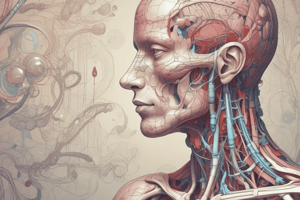Podcast
Questions and Answers
What is the term for the automatic responses to stimuli that do not involve the brain?
What is the term for the automatic responses to stimuli that do not involve the brain?
- Instincts
- Reflexes (correct)
- Habits
- Impulses
What type of sensory receptors detect changes in temperature?
What type of sensory receptors detect changes in temperature?
- Chemoreceptors
- Thermoreceptors (correct)
- Photoreceptors
- Mechanoreceptors
What is the primary function of the nervous system?
What is the primary function of the nervous system?
- To control and coordinate body functions (correct)
- To regulate body temperature
- To facilitate movement and locomotion
- To filter waste and excess substances
What is the term for the 'fight or flight' response triggered by stress or danger?
What is the term for the 'fight or flight' response triggered by stress or danger?
What is the name of the system that consists of the brain and spinal cord?
What is the name of the system that consists of the brain and spinal cord?
What is the term for the withdrawal reflex, which is an automatic response to a stimulus?
What is the term for the withdrawal reflex, which is an automatic response to a stimulus?
Which of the following is NOT a component of the human body?
Which of the following is NOT a component of the human body?
What is the term for the specialized cells or organs that detect and respond to stimuli?
What is the term for the specialized cells or organs that detect and respond to stimuli?
Flashcards are hidden until you start studying
Study Notes
Human Body
- Composed of 11 organ systems that work together to maintain homeostasis
- Organ systems:
- Nervous system
- Circulatory system
- Respiratory system
- Digestive system
- Endocrine system
- Immune system
- Integumentary system
- Muscular system
- Skeletal system
- Urinary system
- Reproductive system
Reflexes
- Automatic responses to stimuli
- Do not involve the brain, but rather the spinal cord
- Examples:
- Withdrawal reflex (e.g., pulling hand away from heat)
- Stretch reflex (e.g., knee-jerk reaction)
- Tendon reflex (e.g., tapping on the patellar tendon)
Nervous System
- Composed of:
- Central nervous system (CNS): brain and spinal cord
- Peripheral nervous system (PNS): nerves that connect CNS to the rest of the body
- Functions:
- Controls and coordinates body functions
- Interprets and responds to stimuli
- Facilitates communication between different parts of the body
Emotional Response
- Also known as the "fight or flight" response
- Triggered by the release of hormones (e.g., adrenaline) in response to stress or danger
- Physiological responses:
- Increased heart rate and blood pressure
- Rapid breathing and increased oxygen intake
- Increased glucose release for energy
- Enhanced mental focus and concentration
Sensory Receptors
- Specialized cells or organs that detect and respond to stimuli
- Types:
- Mechanoreceptors (e.g., touch, pressure, vibration)
- Photoreceptors (e.g., light, vision)
- Thermoreceptors (e.g., temperature)
- Chemoreceptors (e.g., taste, smell)
- Nociceptors (e.g., pain)
Good Behavior (Not directly related to Human Anatomy, but included in the topic list)
- Not a specific concept in human anatomy, but rather a general term
- Can refer to various aspects of behavior, such as:
- Social behavior (e.g., cooperation, empathy)
- Emotional regulation (e.g., self-control, emotional intelligence)
- Moral behavior (e.g., honesty, fairness)
- Healthy habits (e.g., regular exercise, balanced diet)
Human Body
- Composed of 11 organ systems that work together to maintain homeostasis
- Organ systems include nervous, circulatory, respiratory, digestive, endocrine, immune, integumentary, muscular, skeletal, urinary, and reproductive systems
Reflexes
- Automatic responses to stimuli that do not involve the brain, but rather the spinal cord
- Examples include:
- Withdrawal reflex (e.g., pulling hand away from heat)
- Stretch reflex (e.g., knee-jerk reaction)
- Tendon reflex (e.g., tapping on the patellar tendon)
Nervous System
- Composed of central nervous system (CNS: brain and spinal cord) and peripheral nervous system (PNS: nerves connecting CNS to the rest of the body)
- Functions include:
- Controlling and coordinating body functions
- Interpreting and responding to stimuli
- Facilitating communication between different parts of the body
Emotional Response
- Also known as the "fight or flight" response
- Triggered by the release of hormones (e.g., adrenaline) in response to stress or danger
- Physiological responses include:
- Increased heart rate and blood pressure
- Rapid breathing and increased oxygen intake
- Increased glucose release for energy
- Enhanced mental focus and concentration
Sensory Receptors
- Specialized cells or organs that detect and respond to stimuli
- Types include:
- Mechanoreceptors (e.g., touch, pressure, vibration)
- Photoreceptors (e.g., light, vision)
- Thermoreceptors (e.g., temperature)
- Chemoreceptors (e.g., taste, smell)
- Nociceptors (e.g., pain)
Good Behavior
- Not a specific concept in human anatomy, but rather a general term
- Can refer to various aspects of behavior, such as:
- Social behavior (e.g., cooperation, empathy)
- Emotional regulation (e.g., self-control, emotional intelligence)
- Moral behavior (e.g., honesty, fairness)
- Healthy habits (e.g., regular exercise, balanced diet)
Studying That Suits You
Use AI to generate personalized quizzes and flashcards to suit your learning preferences.




